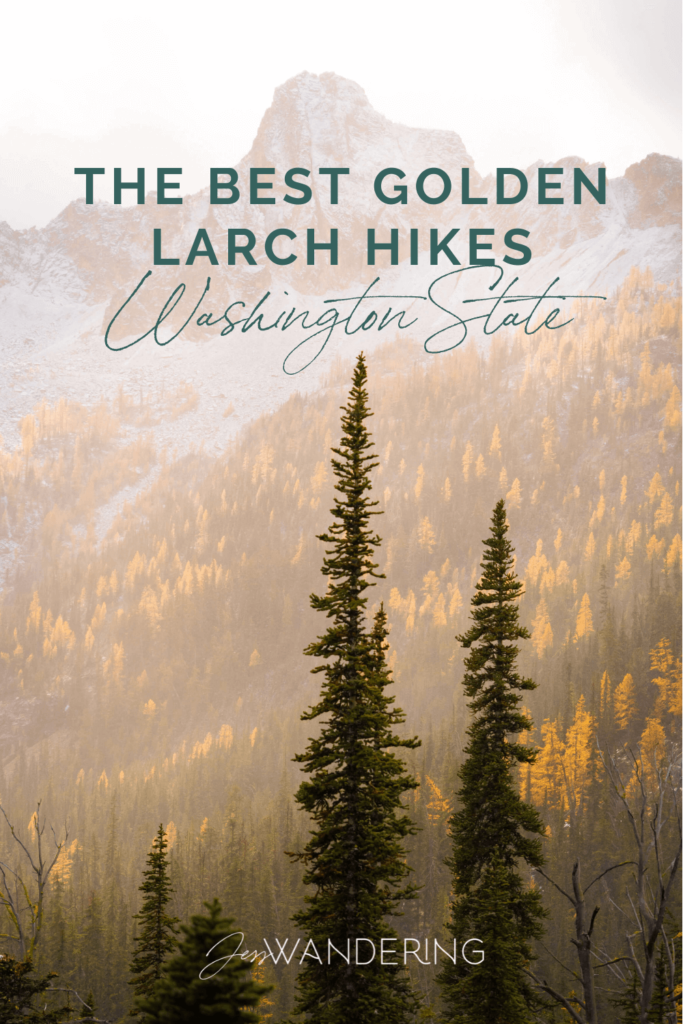
Falling For Larch Madness in Washington State
When the temperatures start to drop and the days become noticeably shorter in Washington, it can be tempting to grab a good book and a cup of coffee and resign yourself to a life of indoor confinement for the next 6 months.
But wait! You don’t need to pack up your hiking boots and submit to a pumpkin spice-induced torpor just yet. There is one last natural phenomenon just starting to unfold on the eastern slopes of the cascades.
Washington’s larches are about to turn a brilliant gold hue! That’s right, those gangly-looking pine trees that you thought were just run-of-the-mill evergreens aren’t evergreens at all. They’re larches.
And I’m here to make sure you don’t miss the show affectionately known as the “Larch March” or “Larch Madness” that is about to unfold in Washington State, giving you some of the best fall hikes in Washington.
Below you will find some of the best Golden Larch hiking trails in Washington for fall season!
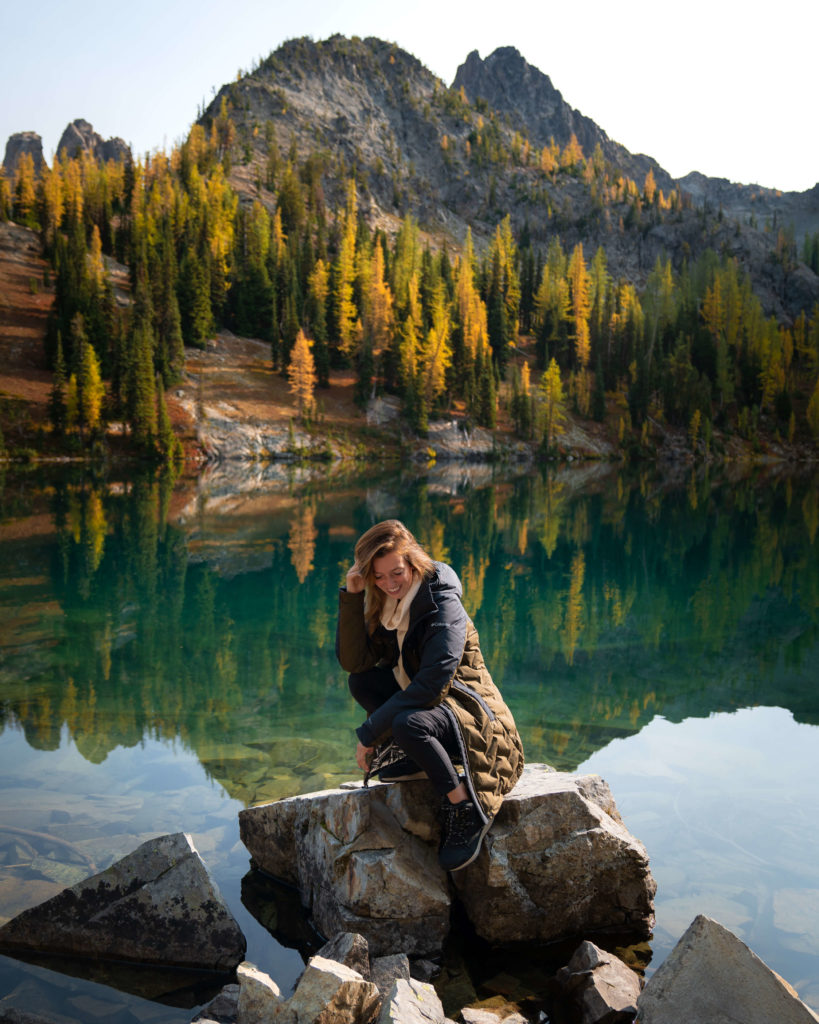
What Are Larch Trees?
They may look like pine trees, but larches are not evergreens like similar-looking conifers that you find through Washington. Instead, larches are actually cleverly disguised deciduous trees (aka deciduous conifers).
That means that, unlike the typical needled tree you see, the needles on larches actually change a brilliant gold color in the fall months before finally falling off the tree in late fall, which is usually late October.
You can find two different kinds of larches in Washington State – the western larch and subalpine larch. Western larches can grow up to 170 feet tall and are located on north-facing slopes between 2,000 and 5,500 feet in elevation.
Subalpine larches, on the other hand, are significantly shorter and grow at higher elevations above 5,500. Needless to say, that means that in Washington State, you are going to need to strap on your hiking boots to see most of the more impressive larch displays!
Where Do Larch Trees Grow in Washington?
With a few exceptions, larches most often can be found on the eastern side of the Cascades. This is because they flourish off the abundant sunlight found in young forests recovering from wildfires.
Western Washington is too wet and dark for larches to truly thrive. When Larch Madness hits each year, you’ll find that Washington’s outdoor enthusiasts start heading east for fall color displays.
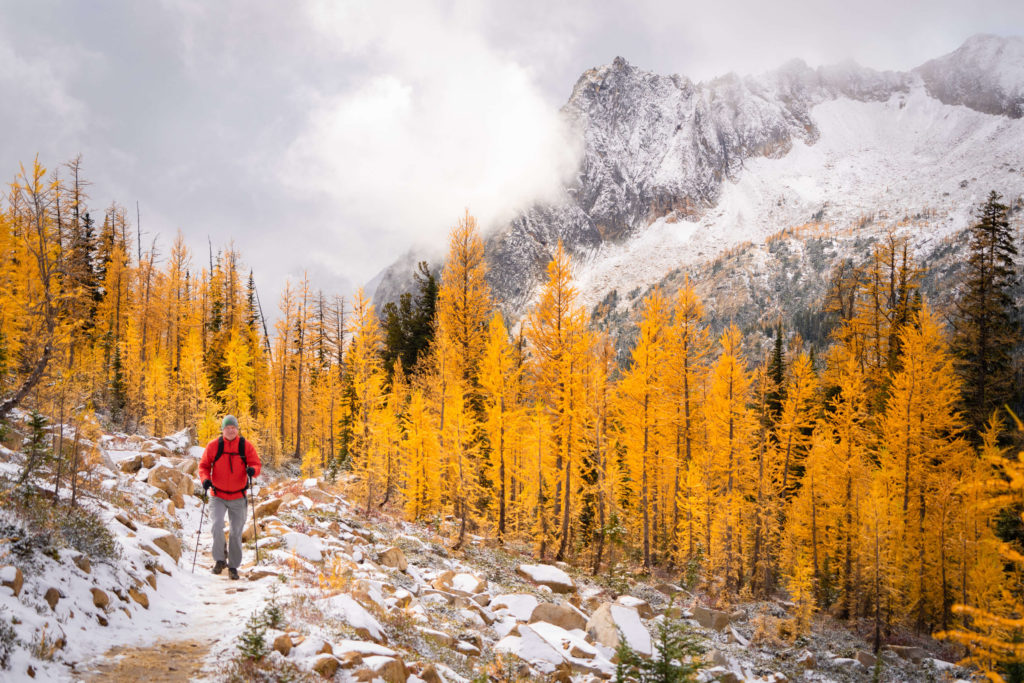
How Long Does Golden Larch Hiking Season Last?
Like most good things, larch season is fleeting. The usually lime green needles start to change color in late September and the best time of year to larches is when the trees hit peak fall colors, which is usually during the first week of October before dropping their needles in late October.
As with all things nature-related, this timeline is just an approximation, and the exact peak season for larches in the state of Washington will vary year by year, and even from hike to hike. In fact, some years, when snow accumulates early in the season, it may not be possible to experience the golden larches at all.
Everything You Need For A Larch Hike In Washington
Whether you are heading out for a quick day hike or something a little more ambitious, the right gear can make the whole experience smoother and way more enjoyable. This is the setup I’ve been using lately out on the trail, including the pieces I reach for again and again because they actually work in real conditions.
Storage
BACKPACK: Osprey Tempest 22 Pack for women and the Osprey Talon 22 for men. My go to when I need a little more space without sacrificing comfort. It carries beautifully, cinches in close, and has enough pockets to keep everything organized without feeling fussy.
RUNNING VEST: I’ve started using a running vest for hikes when I don’t need much gear because it keeps everything light, close, and easy to grab without taking off my pack. The Salomon Active Skin 8 has become my favorite because it fits like a hug, carries water up front, and has just enough space for the basics without ever feeling bulky.
Clothing
SUN SHIRT – The Crater Lake Hoody is my favorite sun shirt because it’s so light and soft it almost feels like air. It offers full UPF 50+ protection for long days in exposed terrain, so I don’t have to carry buckets of sunscreen.
SHORTS – You don’t need to reinvent the wheel here. Whatever works for you! I’ve been really enjoying the Lululemon Pace Rival High Rise Shorts and Outdoor Voices Warmup 5” Shorts.
HIKING PANTS – To be honest I’ve never been a big hiking pants person. I generally just wear one of my favorite pairs of leggings, because that’s what I’m most comfortable in. But this summer I picked up a pair of REI Trailmade Pants and they were nice! The Trailmade Pants are affordable, durable, and surprisingly versatile for hiking and backpacking. And I have to admit it was nice to have a pair of pants that were a bit more airy than leggings.
INSULATED LAYER (Down Jacket) – The Patagonia Fitz Roy Down Jacket is a cold-weather essential I bring on alpine or winter trips when serious warmth is non-negotiable. It’s stuffed with premium 800-fill down, so it’s incredibly warm for its weight. I’d recommend sizing down. But when I’m really trying to go lighter without sacrificing warmth it’s hard to beat Rab’s Mythic G Down Jacket. Best to pick this one up on sale if you can!
RAIN JACKET: The Rab Phantom Jacket is an ultralight, fully waterproof shell that packs down small and disappears in your bag until you need it. I’m a fair weather hiker, but in the mountains weather can change fast, so it’s great to have rain protection that doesn’t weigh me down.
Shoes
TRAIL RUNNERS – The Hoka Challenger Trail Running Shoes is my go-to shoe for warm weather hiking. I prefer trail runners over hiking boots because they’re lighter, more breathable, and dry quickly. I’ve worn mine on everything from day hikes to multi-day trips like the John Muir Trail, and they’ve been incredibly durable for how lightweight they are.
BOOTS – The Danner Inquire Chukka Mid is my favorite hiking boot! I wear it when I want more ankle support than a trail runner but still need something light and flexible. Or when I just want to look cute!
Hiking Gear Essentials
WATER PURIFIER – The Katadyn BeFree is my favorite filter for speed and simplicity. It’s ultralight, easy to squeeze, and perfect for quickly filling bottles on the go.
The Grayl Water Filter is much heavier but unbeatable for international travel or areas with questionable water sources because it removes viruses as well as bacteria and protozoa. It works like a French press—fill, press, and drink—with no need for extra bottles or gear.
HEADLAMP – Nitecore NU25 400 Lumen Rechargeable Headlamp
GPS COMMUNICATION – I carry the Garmin InReach Messenger Plus for peace of mind on backcountry trips — it lets me send texts and share my location even when there’s no service. The battery lasts for days, and it’s a small, reliable way to stay connected and safe when I’m off the grid. AND you can send photos and voice notes! Watch the video I made about the Garmin Messenger Plus! It’s one of my favorites.
SMART WATCH – I’ve been wearing the Garmin Fenix Watch to track my activity for years, and the JMT was no exception.
TREKKING POLES – Durston Iceline Trekking Poles. I just picked up the Durston Iceline Trekking Poles because I wanted something ultralight but sturdy to take pressure off my knees on big hikes. They’re incredibly light (under 10 oz per pair) and I couldn’t be happier with them.
MULTI-TOOL – Swiss Army Classic Knife
FIRST AID – Band-Aids, Leukotape, pain relievers, and antibacterial cream.
POWER BANK – Nitecore Power Bank
Camera
SONY RX100 VII – The Sony RX100 VII is my favorite compact camera for backpacking because it’s small enough to slip in a pocket but still delivers professional-quality photos. The 24–200mm zoom range makes it incredibly versatile, and it’s the perfect option when I don’t want to carry one of my heavier cameras but still care about image quality.
| Just a quick heads up. Some of the links in this post are affiliate links, which means I might earn a tiny commission if you decide to make a purchase. It does not cost you anything, but it’s one of the simplest and most supportive ways to help me keep creating these guides. I’m not paid to recommend anything, and every opinion here comes from real experience with gear I actually use and love. If you’re planning on picking something up, using my link truly makes a difference and I appreciate it more than you know. |
The Best Golden Larch Hiking Trails In Washington State for Fall
There is an abundance of fall hikes in Washington where you can experience golden larches. Here are some of my favorite larch hikes Washington has to offer!
1. Heather Maple Pass Loop Trail
Distance: 7.5 miles
Elevation Gain: 2000
Difficulty: Moderately Difficult
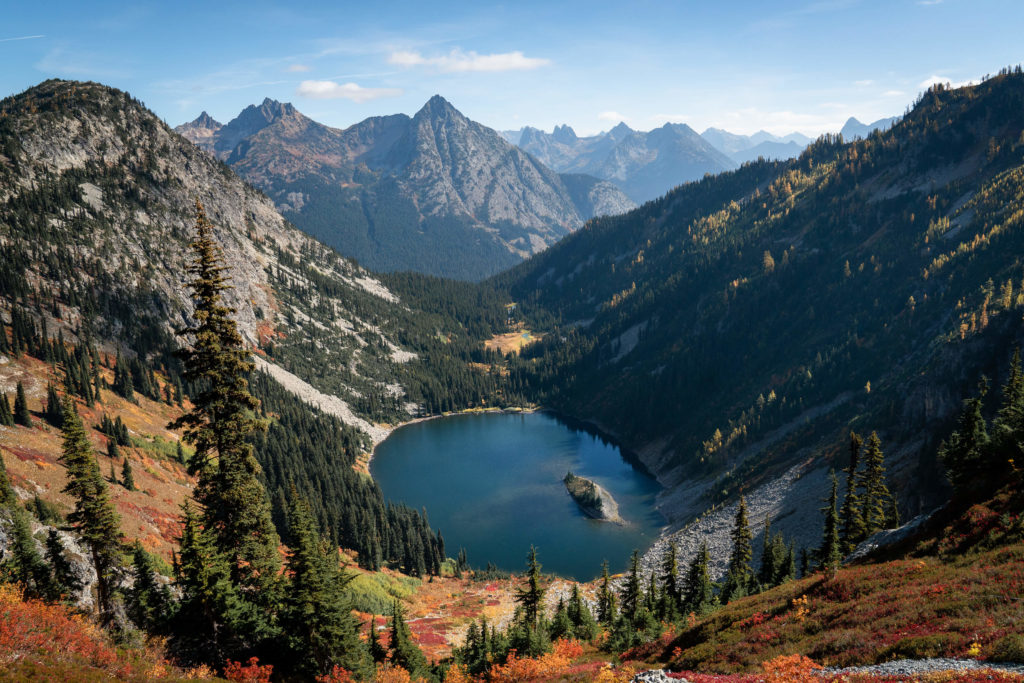
Maple Pass Loop is probably the only fall hike in Washington that I do every single year. Sometimes more than once. Early October is arguably the best time to go because the larches are likely to be at their golden peak. A sight you don’t want to miss!
You can hike the loop trail clockwise or counterclockwise. I’ve done both, and I’m not sure which way is better.
Going clockwise, you get the steep part of the trail over with, and your knees can enjoy a more gradual descent on the home stretch. If you do the hike counterclockwise, the views slowly unfold as you climb, and of course, the climb is a little more gradual on the way up. You can’t really go wrong with this fall hike, though!
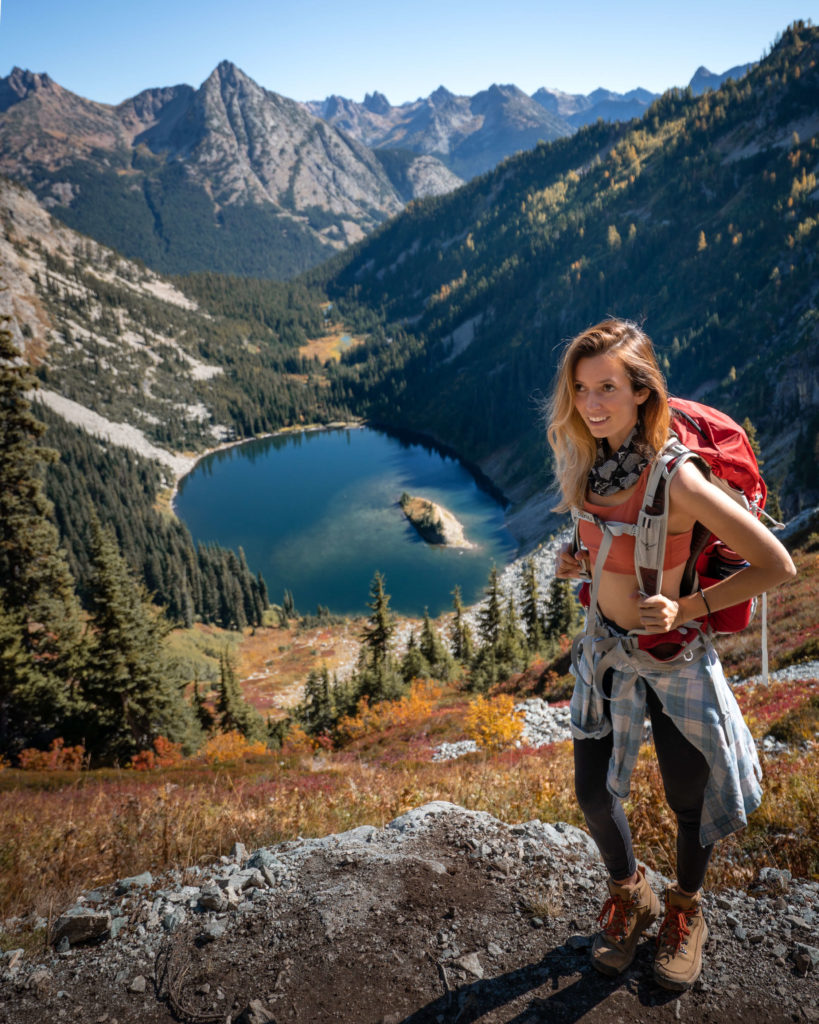
Pro Tip:
Located in the heart of the North Cascades Highway, just getting to the Maple Pass trailhead is a bit of an adventure, but the scenic drive is beautiful. It’s a great excuse to stop and take in the splendid North Cascades National Park views at the Diablo Lake Overlook.
The Heather Maple Pass Loop is one of my Top 10 Favorite Hikes In Washington. Check out the rest here!
2. Cutthroat Pass
Distance: 11 miles RT
Elevation Gain: 2,000 ft.
Difficulty: Moderate
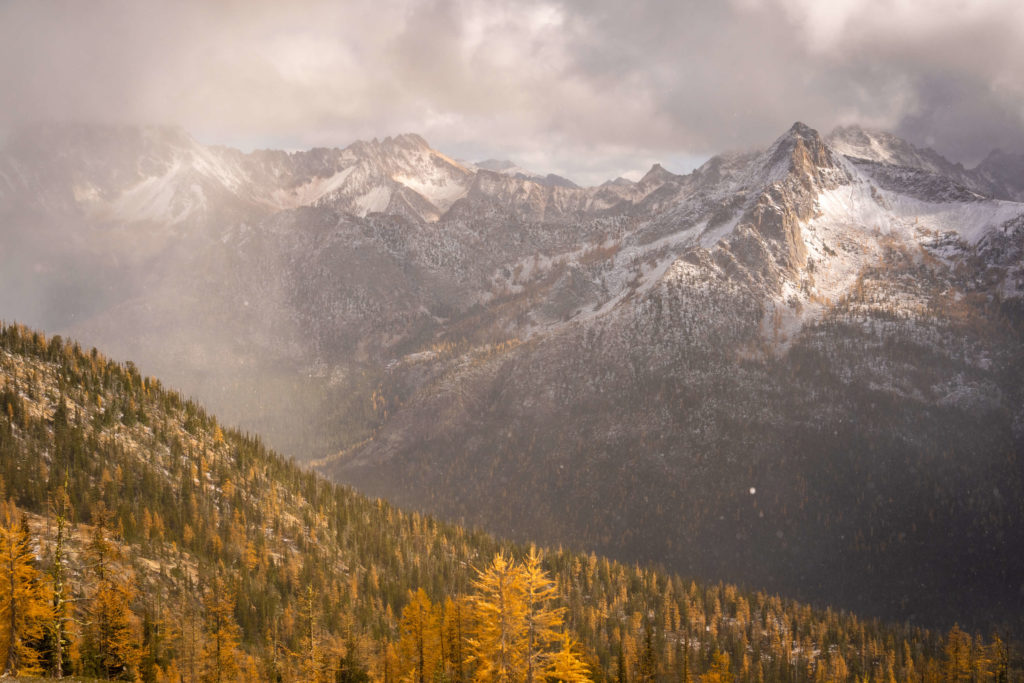
There are two different ways to access Cutthroat Pass. You can hike it from the Pacific Crest Trail (PCT), located across from the Rainy Pass Trailhead on Highway 20. Or you can access the Pass via Cutthroat Lake.
I prefer to do it as a shuttle, starting on the PCT and ending at the Cutthroat Lake Trailhead. Of course, this requires that you have two cars, which won’t always be the case.
Starting on the PCT, the first couple miles of this hike are through lovely but dense forest, so don’t expect a lot of expansive, beautiful views in the beginning – or larches. Around the 3.5 mile mark, the trees start to thin, and you’ll encounter your first golden larches! From here up until the pass, you’ll be hiking in a golden wonderland.
At 5 miles, you’ll reach Cutthroat Pass. From the pass, enjoy expansive views of the North Cascades, golden larches as far as the eye can see, and Cutthroat Lake below you. On a nice, clear day, there are few places better suited for a mountain picnic. Without a doubt one of the best hikes to see the full glory of fall color.
From the pass, you can either continue along the PCT or head down toward Cutthroat Lake and your second car (if you are doing the shuttle). Otherwise, just turn around and continue back the way you came.
Although this trail is long, the gradual grade makes it a relatively easy 11 miles. In fact, it’s one of the most popular trails for trail running, and I even saw a couple of mountain bikers peddling their way up to the pass from the lake.
Pro Tip:
Do this Washington fall hike as a shuttle with one car parked at the Pacific Crest Trail parking lot across from the Rainy Pass Trailhead on Highway 20 and a second car parked at Cutthroat Lake. If you have time, Blue Lake and Heather Maple Pass Loop are also located in this area. Stay in the nearby towns of Mazama or Winthrop and check them all off your list!
3. Blue Lake
Distance: 4.5 miles
Elevation Gain: 1000 ft.
Difficulty: Moderately Easy
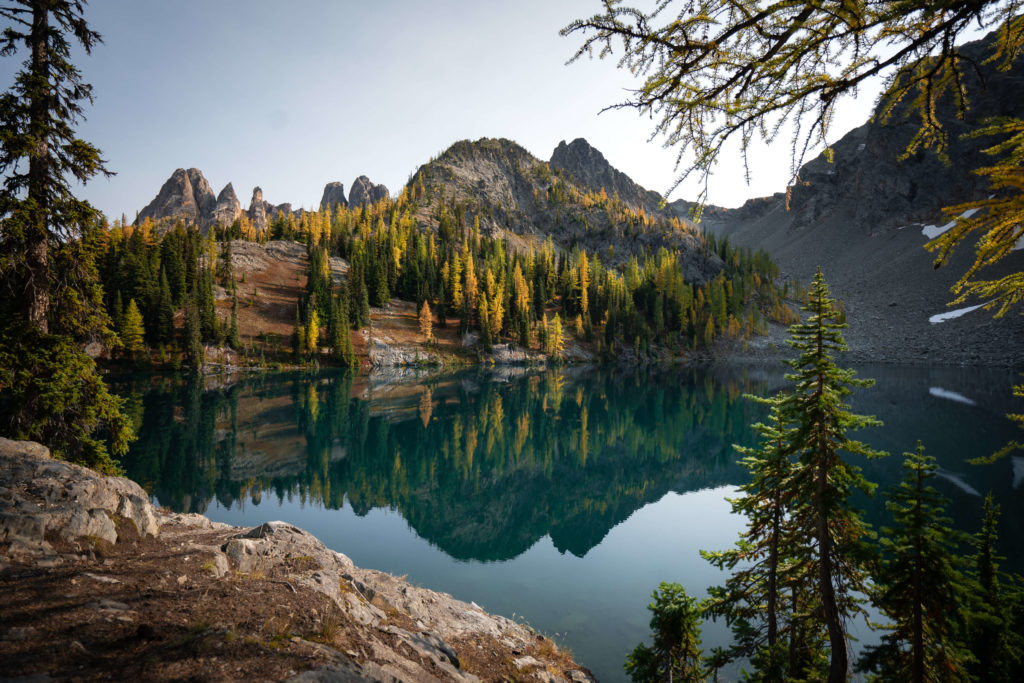
The North Cascades are home to some of the most spectacular alpine scenery in the Pacific Northwest. Not to mention some of the best larch hikes in Washington. If epic is what you’re looking for, then the Cascades have you covered.
Finding a leisurely hike, on the other hand, is a little more complicated. In general, a lot of effort is required to achieve the expansive views that the North Cascades are famous for.
Blue Lake Trail is a welcome exception to this rule. It’s one of the more challenging trails on this list of easy hikes in Washington. Still, it’s not every day that you can experience a shockingly blue alpine lake set against a dramatic mountain cirque in just under 5 miles round trip and it’s a great fall hike for that reason!
The trailhead for Blue Lake is located directly off the North Cascades highway, making it a great way to break up the long drive over Cascade Pass.
Pro Tip:
Before you head home, drive a mile further east on Highway 20, walk a hundred yards or so from the parking area, and check out the Washington Pass Overlook for an absolutely stunning view – and more larches! In fact, this may be one of the few spots where you can witness larches in Washington without leaving your car.
Blue Lake made my list of Top Easy Hikes In Washington That Are Actually Worth It! For more easy hikes in Washington read the article.
4. Colchuck Lake
Distance: 8 miles
Elevation Gain: 2300 ft
Difficulty: Moderately Difficult
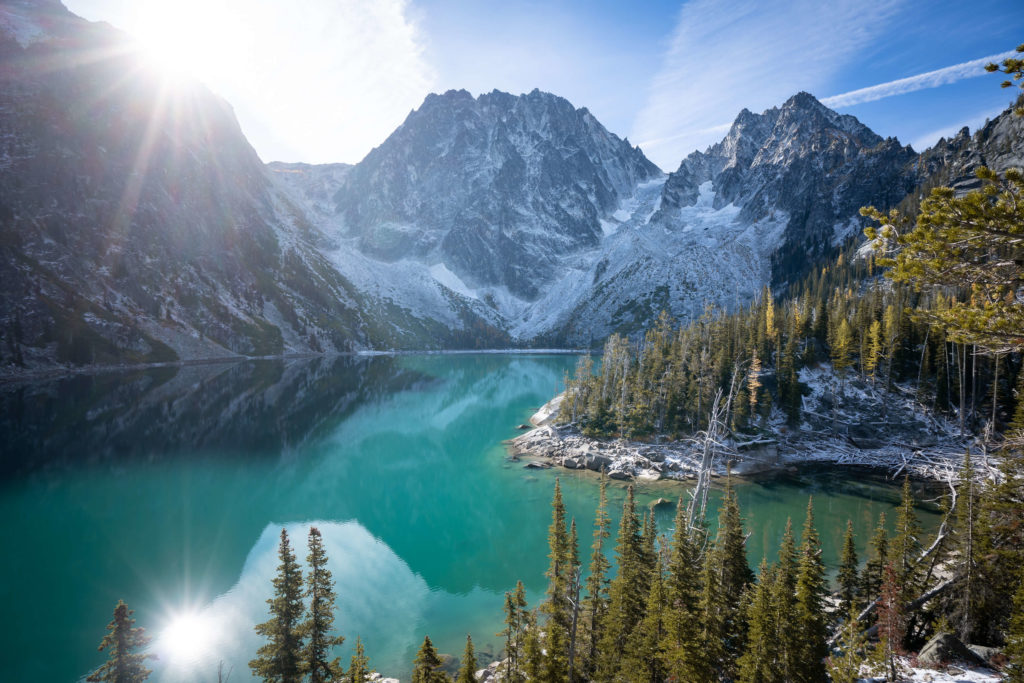
Colchuck Lake is the most popular hike in the Alpine Lakes Wilderness. The Enchantment Lakes are legendary in Washington for a reason. The mountain peaks and many lakes have names based on mythology and magic, and it’s not hard to understand why once you’re there.
Colchuck Lake is the most accessible of these jewel-colored lakes, and I would argue that it’s also the most picturesque in many ways, especially if you’re looking for the best Washington fall hikes. The hike wanders its way through a cool forest, across a river, through a boulder field, and then back up through some more trees before finally opening up to Colchuck Lake.
At around 2.3 miles, you’ll reach a fork in the trail. Turn left to go to Colchuck. If you miss this turn, you’ll end up at Stuart Lake, which is lovely, but you won’t find any larches there.
After the fork, the trail up to Colchuck Lake gets a little more strenuous. Although the route to the lake is well-marked and maintained, there are a lot of roots and rocks to navigate. As a result, you can never really get into a good groove, and you have to constantly pay attention to your footing. But it’s totally worth it for some of the best fall colors!
Pro Tip:
If you have the time and you’re up for the challenge, the views looking down on Colchuck Lake from Aasgard Pass are worth the effort. That being said, don’t underestimate the amount of time this undertaking will likely require.
Hiking 2000 feet in just three-quarters of a mile is no joke! If you’d like to spend more time exploring Colchuck Lake and its enchanted siblings, you can apply for backcountry permits on the recreation.gov website.
5. The Core Enchantments
Distance: Approximately 19 miles
Total Elevation Gain: 5,000 feet
Total Elevation Loss: 7,000 feet
Difficulty: Extremely Difficult
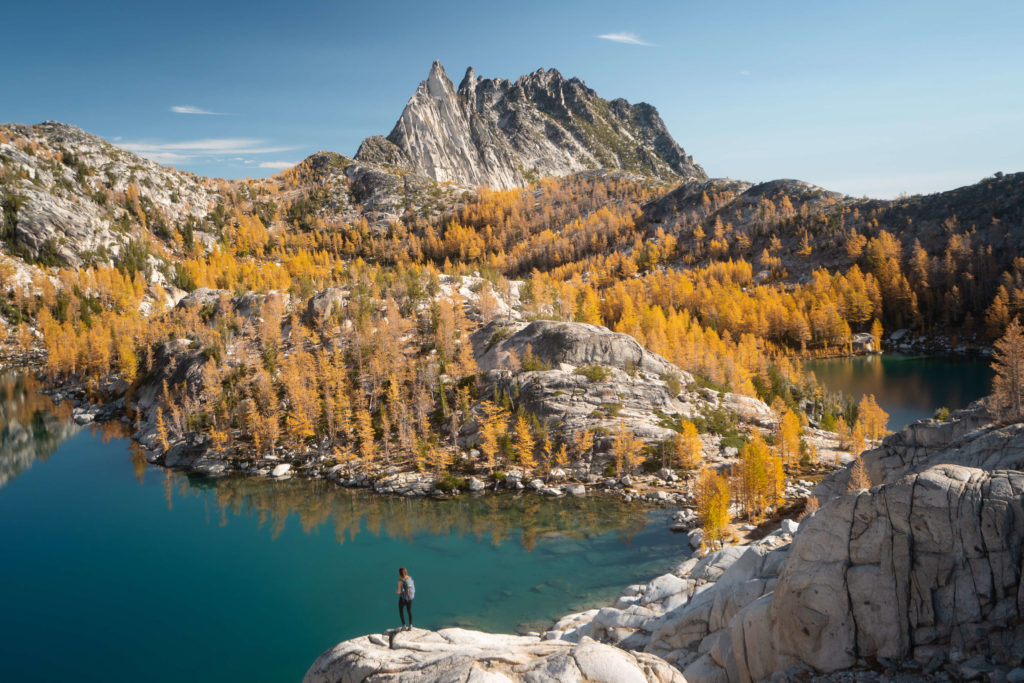
Growing up in Washington, hiking The Enchantments feels a bit like a rite of passage. Even more during larch season. And yet, somehow, the core zone of The Enchantments alluded me for years, mainly because this area requires permits for overnight trips.
I’ve never been one of the lucky few to win an overnight permit into the “Core Enchantments.” And I’ve always convinced myself that I wasn’t up for doing the thru-hike in one day. But that’s rubbish!
Yes, it’s a strenuous hike. Yes, hiking 20ish miles in a single go makes for a very long day. But I honestly think that anyone in reasonably good shape can day hike The Enchantments.
Like most long-distance endeavors, it’s more of a mental challenge than anything else. But when the views live up to their name, as they do in The Enchantments, even the mental challenge is easily surmountable.
Check out my guide on thru-hiking the Enchantments in one day for detailed information on how to check this bucket list hike off your list!

6. Lake Ingalls
Distance: 9 miles RT
Elevation Gain: 2,500 ft.
Difficulty: Moderate
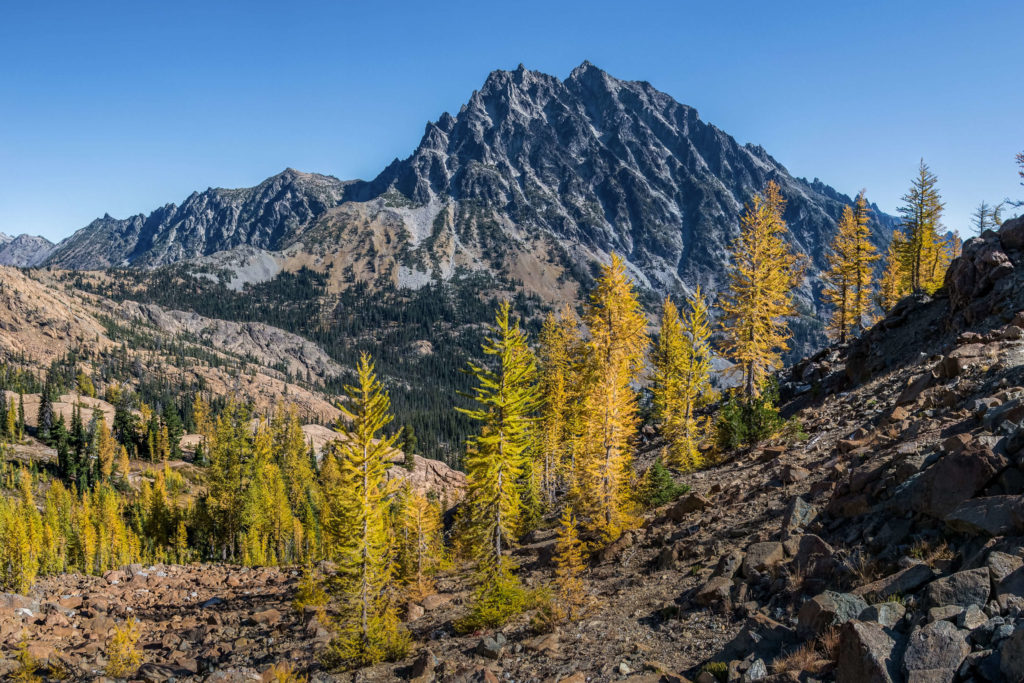
Early season larches in Washington just beginning to change from green over to gold on the trail up to Lake Ingalls. Photo by Sergei A
Lake Ingalls in the Alpine Lakes Wilderness is one of the most popular hikes for golden larches Washington has to offer. The trail starts from the parking lot, following the North Fork of the Teanaway River for a short distance before branching off to Lake Ingalls. You’ll pass through several ecosystems on your way up to the lake, and while the trail is steep in places, the views are absolutely worth the effort.
At two miles up, another trail junction occurs. The left (straight) trail takes you upwards to Ingalls Pass and to Lake Ingalls. At the top of the pass, stop to enjoy views of Mt. Rainier, Mt. Adams, and Mt. Stuart. The next mile will take you through Headlight Basin, where you’ll be able to get up close and personal with golden larches one one of the best fall color hikes.
From the pass, there are two paths up to Lake Ingalls. The more defined trail to the left is the lower trail. It will take you on a meandering down the pass towards the lake. The upper path to the right offers a more direct, albeit rough route to Lake Ingalls. Having a GPS map of the area downloaded on your phone can come in very handy for this section of the hike.
7. Carne Mountain
Distance: 8 miles
Elevation Gain: 3,600 ft.
Difficulty: Difficult
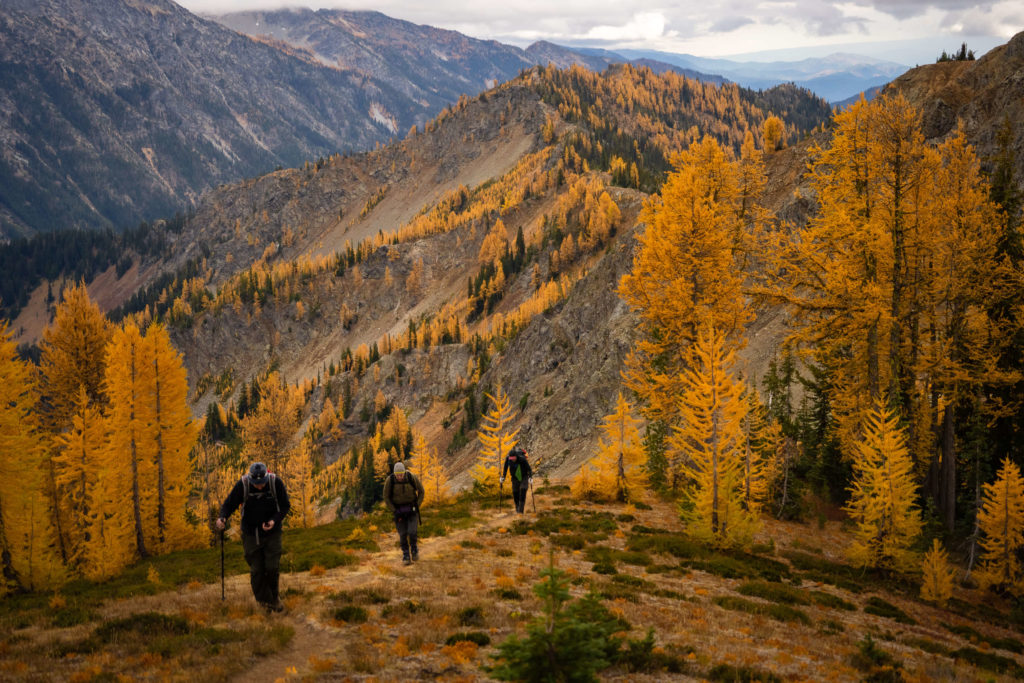
Except for day hiking The Core Enchantments, this is the most strenuous fall hiking trail on the list. Not only that, but if you are coming from the Seattle area, the drive is pretty horrendous. For those reasons, I thought we would find some solitude on the trail to Carne Mountain.
Boy, was I wrong! I can honestly say that this was the busiest I have ever seen a hiking trail in Washington. To be fair, it was a Saturday during peak larch season. But it was also pretty crappy weather, so go figure.
I mention this not because I want to persuade you from hiking Carne Mountain. I don’t! It’s on my list of best larch hikes in Washington for a reason. But I also think that it’s essential to set realistic expectations if you plan to do this popular fall hike.
If you show up on the weekend during larch season, you will likely be sharing the trail up to Carne Mountain with hundreds of other hikers and their dogs. Fair warning.
Now for the good stuff! Start out on the Phelps Creek Trail 0.25 miles to the Carne Mountain Trail. Once you are on the Carne Mountain Trail, you are looking at approximately 3 miles of relentless switchbacks through dense forest before you finally break out into a basin filled with golden larches.
It can be tempting to stop here, and I noticed that many people did just that. I encourage you to keep going! Trust me, the final push up to the summit is well worth it and nothing compared to what you have already completed.
Turn left at the Old Gin Trail junction and head up to the saddle between Carne Mountains’ two summits. The higher of the two is to the left. From there, enjoy 360-degree views and larches as far as the eye can see!
Pro Tip:
Carne is pronounced “karn” as opposed to “kar-nay.”
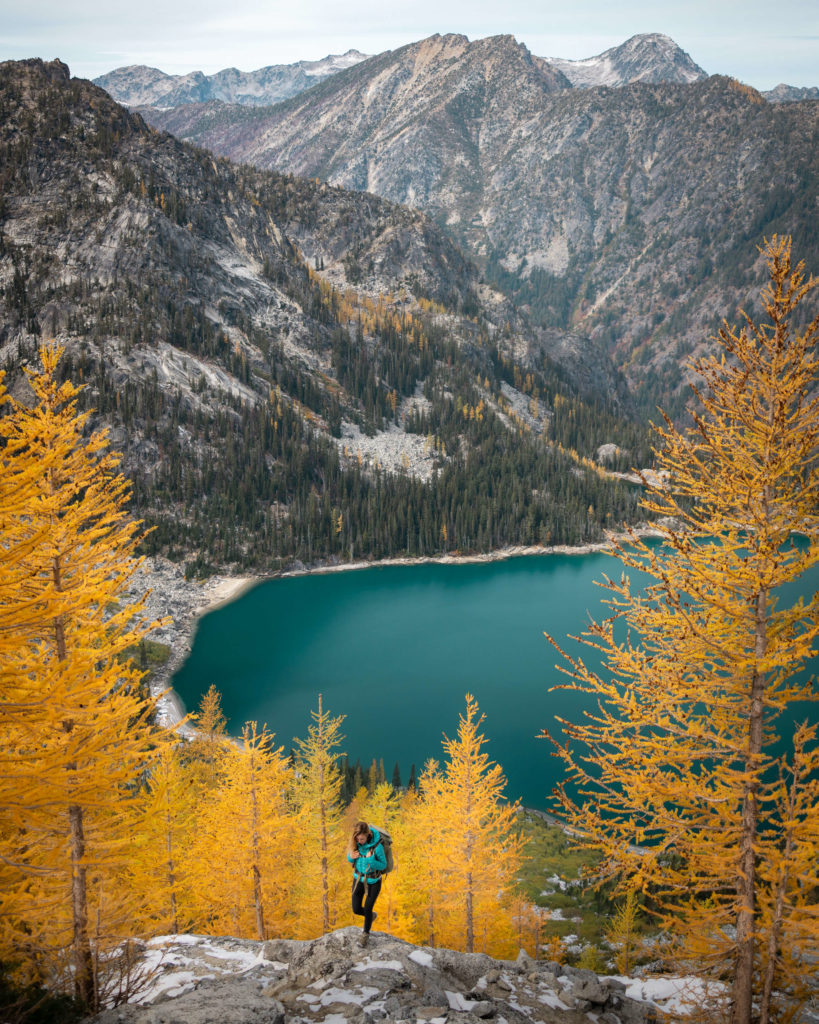
What To Wear On Your Golden Larch Hike In Washington
Larches grow at high elevation which means that you should be prepared for a wide range of trail conditions on your larch hike. The weather can change quickly and dramatically in Washington’s mountains, and it’s essential to be prepared for anything Mother Nature feels like throwing your way.
Day Pack: Ospreys Sirrus 36L Backpack is my favorite day pack. It’s not the lightest pack I own, but I find that with the support it offers—including padded waist straps—it’s much more comfortable than many ultralight packs. The Sirrus 24L Backpack, is also a great option. The Sirrus line has an integrated rain cover as well! I also like Patagonia’s 9 Trails Backpack.
Down Jacket: Arc’teryx Cerium LT Hooded Down Jacket is my go-to layer for warmth right now. It has an excellent warmth-to-weight ratio and packs down to nothing in my bag – perfect for cooler temperatures.
Rain Jacket: Rab Kinetic Plus Hooded Jacket is hands down the best waterproof jacket I’ve owned. It’s the perfect blend of comfort and function for cooler weather and rainy days in the Evergreen State.
Breathable Base Layer: When you need temperature regulation and comfort over the long haul, Icebreaker base layers are a great, environmentally friendly option.
Hiking Boots: I always hesitate to recommend hiking shoes because I know that everyone has different preferences, and what works for me won’t necessarily work for you. That being said, I’m on my third pair of Keen Terridoras (in three years), and when my current pair falls apart, I’ll probably get another pair.
Good Hiking Socks: Merino fibers naturally resist odor during extended use while also providing superior breathability and softness. I own a few pairs of these Darn Tough socks and a couple of Smartwool socks, and I honestly love them equally.
Ten Essentials: Whether you’re going on a short day hike or camping deep in the backcountry, you should always carry The TEN ESSENTIALS for outdoor adventure with you. They might just save your life!
Headlamp: Days are short during October in the Pacific Northwest, so it’s always a good idea to carry a light with you. There are fancier headlamps out there, but I like to keep it simple. The Petzl Actik Core Headlamp is easy to operate, very lightweight, and charging is a breeze with a micro-USB or AAA batteries.
Leave No Trace
Leave No Trace is built on seven core principles that outline the best available minimum impact guidance for enjoying the outdoors responsibly. The principles include:
- Plan Ahead and Prepare
- Travel and Camp on Durable Surfaces (aka stay on the trail)
- Dispose of Waste Properly (use the provided pit toilets)
- Leave What You Find
- Minimize Campfire Impacts (There are no campfires permitted in The Enchantments)
- Respect Wildlife
- Be Considerate of Other Visitors
I encourage you to visit The Leave No Trace Center for Outdoor Ethics for more details regarding these principles, as well as information on how you can protect the beautiful places we all love so much.
I hope that this post can help you experience the magic of Larch Madness in Washington State! There are so many beautiful golden larch hikes in Washington it was hard to narrow down the list.
Do you have a favorite fall hike or golden larch hike in Washington that I missed? I’d love to hear about it in the comments.
Happy Hiking!
Jess
Don’t Miss These Posts!
Cozy Pacific Northwest Cabins You Can Rent!
Complete Backpacking Gear Check List
Nine Fun Ways To Get Through A Washington Winter
Cold Weather Camping Hacks That Will Keep You Warm!
Must Do Hikes On New Zealand’s South Island
Like this post? Pin it for later and share it with others!


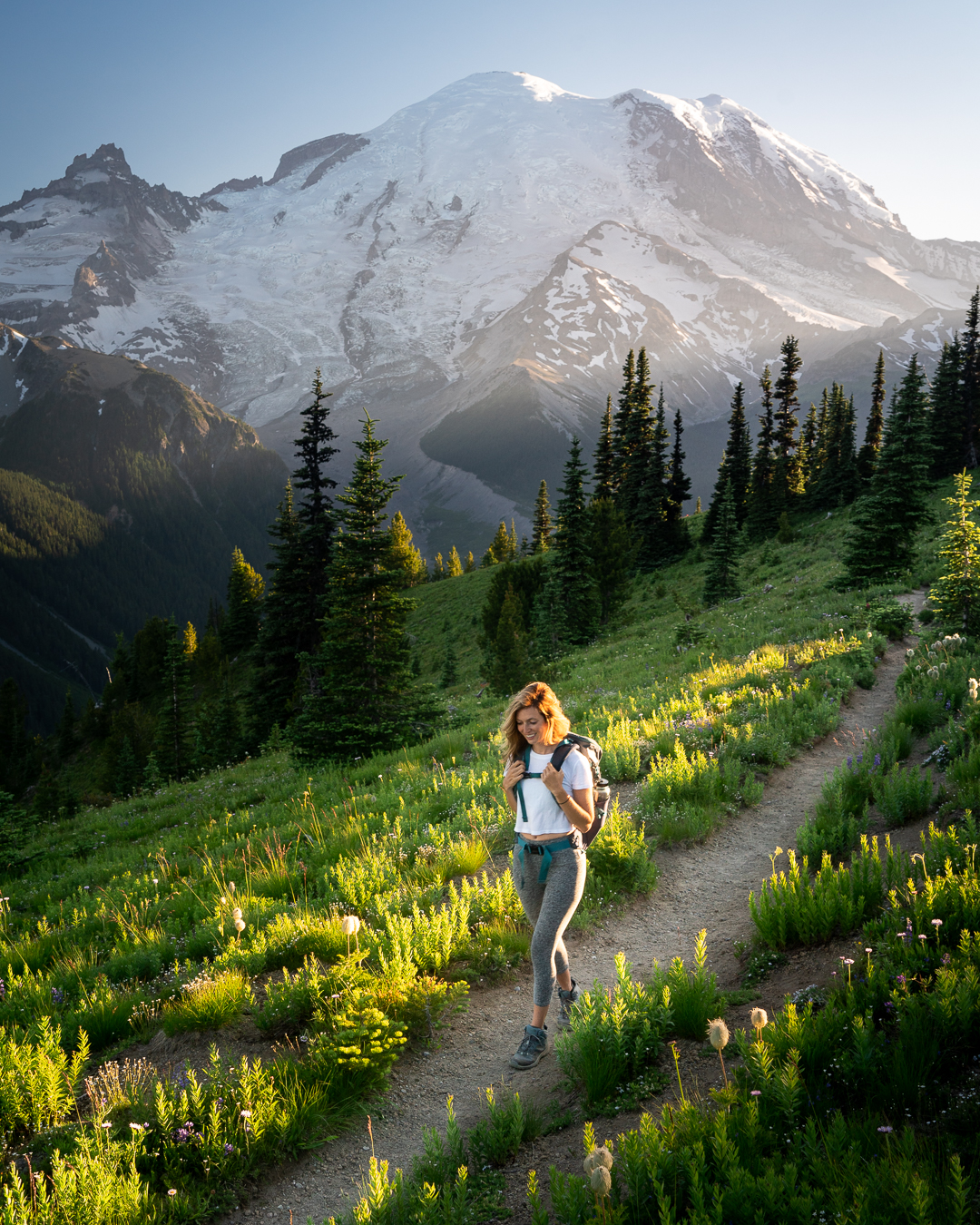
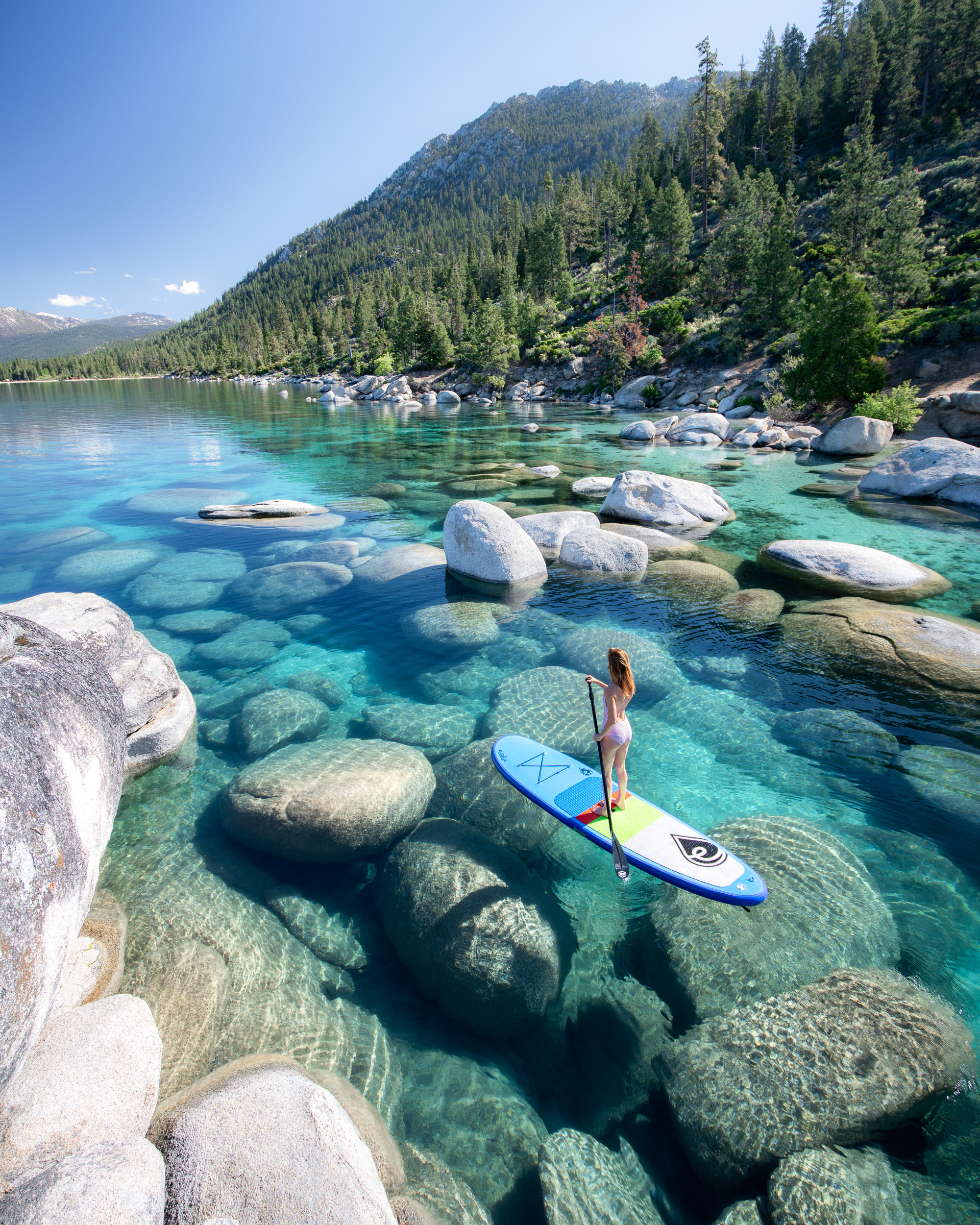
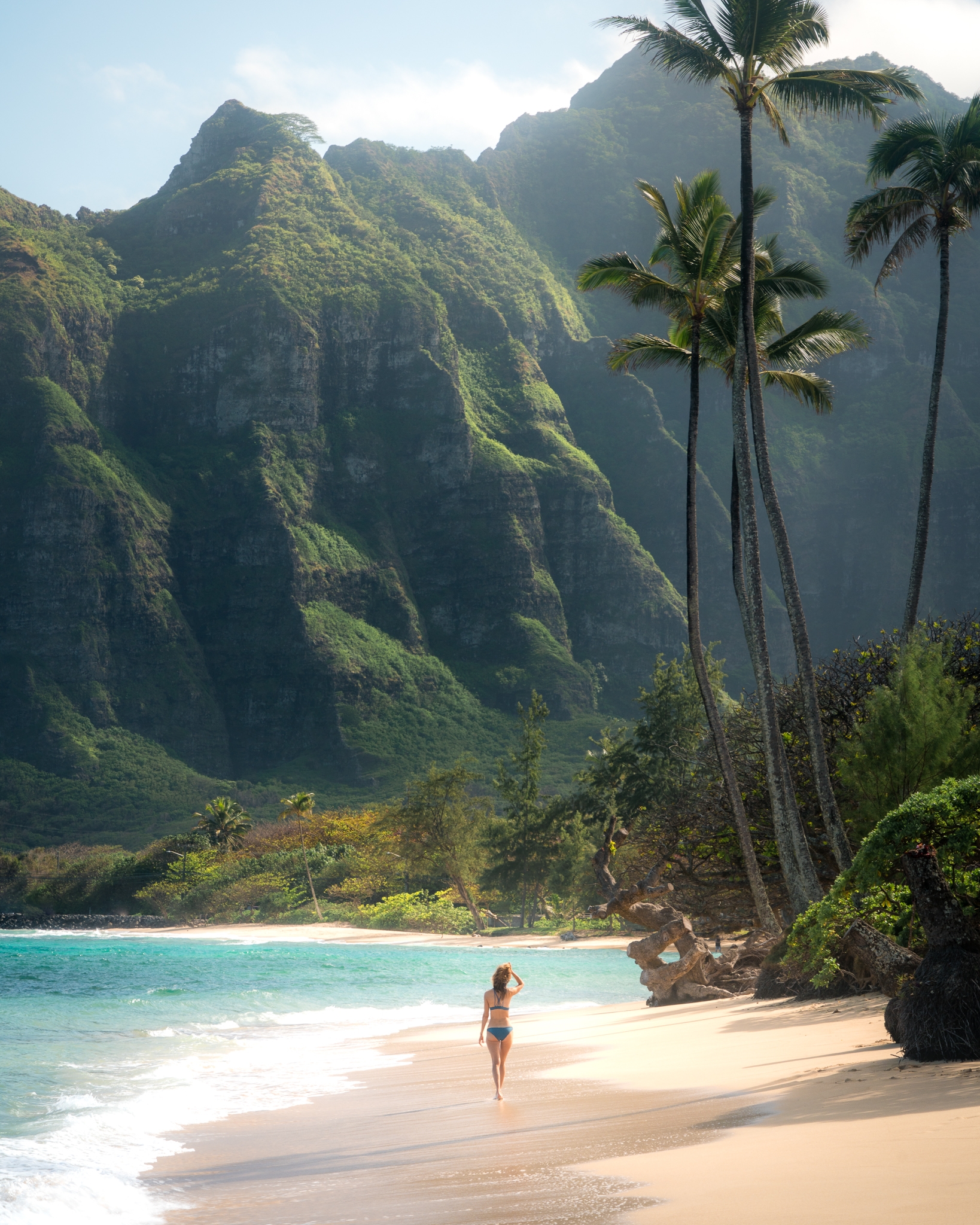
Such a great write up and gear tips! Will have to check out Washington in the fall, someday.
Thanks so much Scott! Early fall is one of my favorite times to be in Washington.
Hi Jess,
I’m curious, did you hike Carne Mt on Saturday 10/9/21? As I was descending I passed someone who I thought might have been you in a plaid shirt. 🙂
Hi Dorian! I can’t remember the exact date, but that does sound right. And I was wearing a plaid shirt. Hope you had a lovely hike. 🙂
Beautiful pictures! I’ve done several of these hikes, but only a few with the larches!
Thanks Everett! Many of these are great before larch season as well, as I’m sure you experienced during your hikes. Hope you had a lovely larch season this year. We had incredible weather. 🙂
Thank You for writing this page, and apologies for this long post, edit as needed, hope it’s worth it!
I have been to Lake Ingalls twice now, last Oct at the end of the Larch Gold, and last week for three days, two nights in Headlight Basin. While the larches are green now, the geography of that area is just stunning! On the middle day, I teamed up with another older backpacker (I’m 68), and we went to the lake and also around to the north side, over a ton of large rocks needing occasional handgrips. He helped me with my one armed disability in two spots. The north side of the lake has an idyllic curving shoreline that made it worth the almost hour long hard rock route with a fair number of cairns to mark the way. I also hiked partway out towards Stuart Pass, to look down the valley Jack Creek runs through to Leavenworth. BONUS, I was able to see Glacier Peak to the north, that took my breath! Later that evening I was able to catch 2 dozen photos as the sunset cast a orange/reddish glow on Mt Stuart. If only I had not lost my phone in Cle Elum on the way home, BIG sigh.
Anyway, thank you for helping me discover another area! I have lived next to Rattlesnake Ledge for nearly 35 years, and the crowds make me need venture elsewhere.
Hi Bruce. My apologies for such a delayed response. I’m happy that you were able to make it up to Lake Ingalls and that you had a companion to help you out with some of the more technical parts. That’s not an easy hike! I’m sure it was lovely to spend the night up there. Rattlesnake Ledge certainly has gotten quite busy. Although it’s still nice to keep the legs in shape during the off season. Have a wonderful weekend!